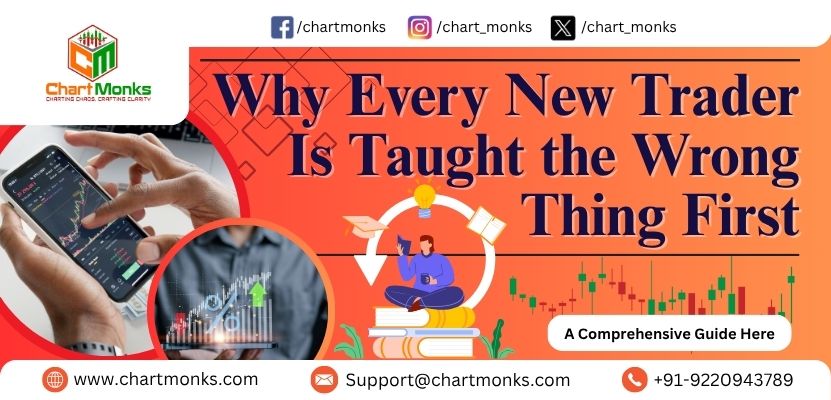Let’s cut the fluff.
Most people don’t learn how to trade stocks — they jump into trading.
Because someone on YouTube showed a ₹1.2 lakh profit in 15 minutes.
Because a friend made 30% “in just 2 days.”
Because the bank fixed deposit is too slow.
Because “how hard can it really be?”
And just like someone thrown into the deep end of a pool without knowing how to swim — they panic.
They flail around.
They lose money.
They download indicators.
They join signal groups.
They blame emotions.
They try again.
But here’s the problem:
They never actually learned to trade.
They learned how to react.
Trading Is a Skill. But Most Treat It Like a Shortcut.
Look around.
There’s no shortage of trading courses online — thousands of them.
Most of them promise simple strategies, secret patterns, or one “risk-free” setup.
But none of them prepare your mind for the real thing:
- The waiting
- The silence
- The confusion
- The “nothing is happening” days
- The one candle that changes everything
Why?
Because real trading isn’t content. It’s craft.
And you can’t learn craft by watching someone else’s chart for 10 minutes.
That’s why we built Chart Monks — to help you learn trading from scratch, not from recycled YouTube formulas but from real market behavior.
Nobody Teaches You How to Think in Trading — Only What to Do
Most traders start with one dangerous habit: copying.
- Copy the breakout setup
- Copy the Fibonacci numbers
- Copy the entry/exit of a mentor
- Copy the bias from a Twitter post
But here’s the thing:
Copying doesn’t build understanding.
It builds dependence.
You might win for a while. But when the market shifts, you won’t know why it shifted — and you’ll be stuck.
That’s why our online trading course in India doesn’t teach copy-paste systems.
We teach thinking — raw, price-based logic using demand and supply.
No indicators.
No shortcuts.
Just decision-making from the ground up.
Learn Trading Like You’d Learn a Martial Art
Think of this:
If someone asked to learn martial arts in one day, you'd laugh.
But traders expect to become consistent with a few videos and a demo account.
That’s the delusion the trading industry sells.
Trading, like martial arts, requires:
- Awareness
- Timing
- Discipline
- Defense
- Patience
- Reaction control
And just like a good fighter never swings blindly, a good trader doesn’t take random setups.
They wait.
They read.
They act only when the opponent (price) is off-balance.
That’s demand and supply.
That’s how we teach you to trade at Chart Monks.
And we do it in Hindi too — through our full trading course in Hindi, designed for traders who think in their native language and want clarity without fluff.
Real Traders Don’t Look for Confirmation. They Wait for Imbalance.
Here’s what separates pros from amateurs:
- Amateurs look for confirmations.
- Professionals look for imbalance.
Let me explain.
When price moves aggressively in one direction, it means one side — buyers or sellers — took control.
That’s a clue. That’s a footprint.
And when price returns to that origin zone, that’s your opportunity.
We don’t chase breakouts.
We don’t draw 10 lines on the chart.
We don’t use 3 indicators to feel safe.
We sat back.
Mark demand or supply zones.
And strike only when the market gives us the right reaction.
That’s real trading.
That’s how you should learn how to trade stocks — with calm logic, not chaos.
The Most Dangerous Trader Is Not the One With the Most Tools — It’s the One With the Most Clarity
Ever met a trader with a chart that looks like a spaceship dashboard?
They’ve got:
- 5 indicators
- 4 zones
- Trendlines from last Diwali
- And a mental checklist of 18 confirmations
But they still don’t know what to do when the price drops 2 candles fast.
Because more tools ≠ more clarity.
Real clarity comes when you can open a blank chart and ask:
- Where is the imbalance?
- Where did price move strongly from?
- Where are unfilled orders likely stacked?
That’s what we train your eyes to see in our trading courses online.
We turn noise into structure.
Confusion into control.
Why a Price-Action-Only Approach Is Mentally Liberating
There’s a strange peace that comes when you stop using indicators.
You don’t wait for confirmation anymore.
You don’t ask if RSI is overbought.
You don’t care what the moving average says.
You just read the chart.
You see the price for what it is — a reflection of buying and selling pressure.
And once you learn to trust that — trading becomes simple.
Not easy, but clear.
That’s what most traders are secretly looking for — clarity.
And it comes only from understanding raw price.
What We Teach (And What We Will Never Teach)
You will NOT learn:
- Indicators
- Support/Resistance hacks
- Trendlines
- Candlestick patterns like doji/hammers
- Multi-timeframe confluences
You WILL learn:
- Demand and Supply (the real kind — not textbook junk)
- How to identify imbalance
- How to mark zones that actually work
- When to wait, when to strike
- How to build mental discipline from price logic
And you’ll learn it in your own language, with our full trading course in Hindi, designed for Indian learners who want real, no-nonsense education.
Final Truth: Trading Doesn’t Make You Emotional. It Exposes the Emotions You Hide.
Most people say “trading is emotional.”
That’s not true.
Trading reveals what’s already inside you:
- Impatience
- FOMO
- Fear of being wrong
- Ego
- The need to be right
The market doesn’t create these emotions — it amplifies them.
So the deeper you go into trading, the more you realize this is not just about charts.
This is about self-awareness.
And the only way to develop that awareness is through a framework that forces you to slow down, observe, and act with logic — not reaction.
That’s why our online trading course in India is designed like a mirror.
To help you build real skill, real conviction, and a mindset that doesn’t crack when price does.
Ready to stop floating in the market and start swimming with purpose?
Then don’t “try trading.”
Train for it.
Join the only full trading course in Hindi that shows you how to build your edge from scratch — with pure price action, zero fluff, and full honesty.
Not a strategy. A way of seeing.



